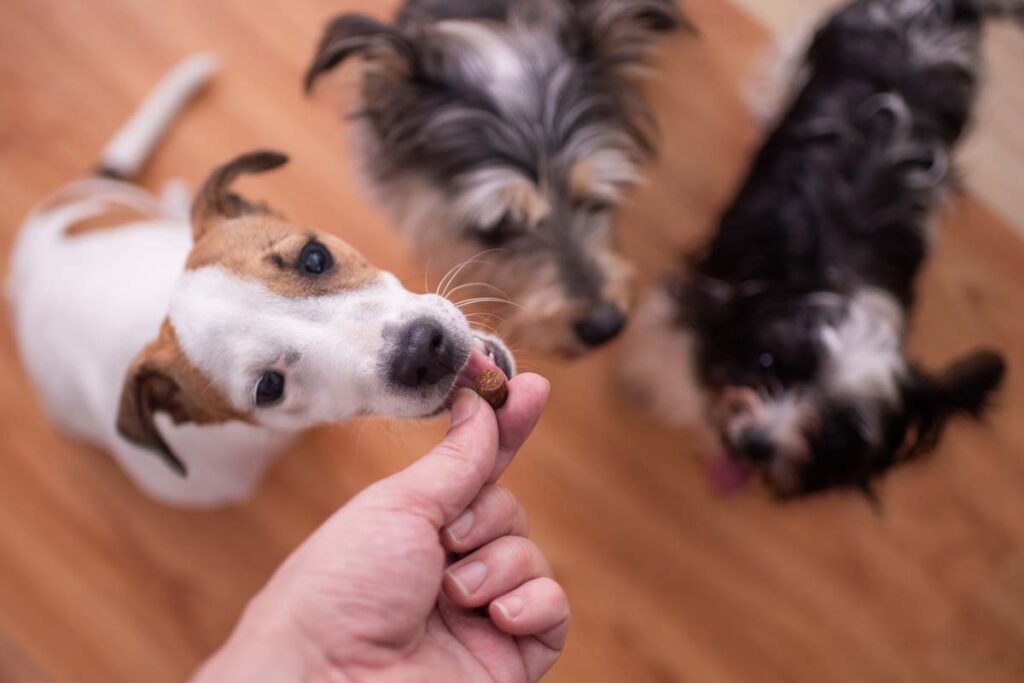You can never have too much of a good thing, right? When it comes to pets, a multi-dog household (comprising three or more dogs) means more playtime, snuggles, and joy — but it also comes with the potential for conflict.
How can you keep the peace among family members, both human and canine, in multiple human and dog households?
Dogs and social dynamics
When it comes to dog dynamics, some theories die hard. Most pet parents have encountered the persistent idea of the ‘wolf pack,’ where one member fights for dominance, using force to obtain and maintain the status of the ‘alpha.’ For many years, pet owners were sold the idea that their dogs inherited an innate desire for hierarchy from their wolf ancestors. Training models reflected this idea, with an emphasis on displays of dominance and even punishment to establish a rigid alpha-beta dynamic.
While it’s true that our pups have retained echoes of the pack structure from their wolf-like ancestors, research in the past two decades has revealed the line between the social structures of large wolf packs and domesticated dogs is not so clear-cut— the reality is a lot more nuanced. Many millennia of human domestication have also shaped our dog’s behaviors significantly, adapting them to human cohabitation.
Pack Dynamics in Multi-Dog Households
The good news? You’re not living with a wolf pack. Nonetheless, like any group-living situation, there will be moments of conflict between members — though this is more likely to be provoked by resource-sharing, breed, and personality types than by an alpha-beta supremacy struggle. According to the University of Edinburgh School of Veterinary Studies: “There is no dominance or linear hierarchy for dogs. There is no ‘alpha’, or ‘top dog’, nobody is constantly fighting for supremacy, and nobody is trying to overthrow the leader through aggression or dominance.” Simply put, the constant fight for dominance among a dog pack would be far too fraught and difficult of a dynamic to maintain.
However, as a multiple-dog owner, it is essential for you to observe and understand the dynamic of your personal pack. Like humans, dogs have personalities and traits. Factors like breed, age, sex, and environment play a significant role in how your dog behaves toward others. One might be food-focused and therefore act more assertively at dinnertime, while another might push to receive more physical attention from its humans. Small skirmishes are nothing to worry about, as long as they don’t escalate into aggressive behavior. This outcome is mostly determined by you. Socialization, training, and clear boundaries are the responsibility of the human pack members in order to shape polite and well-behaved dogs who are able to cohabitate without major conflict. The more dog members in the family pack, the more in control the human pack members need to be.
Adding a new dog to your pack
When you bring home another new canine pack member, the dynamics of the household can be thrown off-kilter as the dogs establish relationships and adapt to a new family dynamic. The result? “If a dog comes into a home that already has canine members, an opportunity arises for expression of inter-dog behaviors,” writes Veterinary Behaviorist Soraya Juarbe-Diaz. “Some may be unacceptable to the owner, even though they are normal within the scope of canine social behavior.”
What can you expect from this period of adjustment?
- Increased vocalization
- Play fighting, which has the potential to escalate into aggressive behavior
- Resource guarding
Training
As discussed, having a multi-dog household requires and level of training and control to maintain a healthy and happy home environment. So how do you successfully train a dog when there are several competing for your attention? The key to effective training depends on being able to reward at the exact moment when the correct behavior occurs. Awarding a dog with treats or affection can be difficult when there is another pet vying for the same reward.
The American Kennel Club outlines the “Three Ds of Dog Training” as such: distance, duration, and distraction. In multi-dog households, distraction is often the limiting factor.
Below are some tips to make training a little smoother:
Separation
Reduce distraction and get each dog’s entire focus when teaching the fundamentals, such as sit, stay, and come. You can do this by taking each dog on its own walk, or by occupying the other dogs in another room with chews or toys to occupy them. If you are unable to physically separate the dogs, either leash or crate the others.
Keep it Short
Train in short bursts of five to ten minutes with clear direction and reward, before retiring the working dog and swapping in the next.
Name Recognition is Key
Once you have mastered the basics, you need to be able to give individual commands in a group setting. This is when name recognition is key. Give each dog’s name before any cue while you maintain eye contact to ensure they understand they are being addressed.
Don’t forget to add distance training to the mix as each dog becomes more comfortable with the fundamentals. In general, the larger the distance between you and your dog, the less reliable their behavior becomes. Practice “distance training” in small steps – have your pup practice the desired behavior (such as “stay”) within a short distance from you and slowly increase the distance out from there.
The Bottom Line
Having a multi-dog household brings moments of playfulness, companionship, and shared love. Understanding the unique personalities, breeds, and needs of each canine family member is the key to fostering a healthy group dynamic. Introducing a new dog to the group requires careful observation and management of inter-dog behaviors during the adjustment period. Ultimately, with thoughtful consideration, clear boundaries, and proper training, a multi-dog household can thrive, providing a fulfilling environment for both human and canine members alike.
Information resources:








